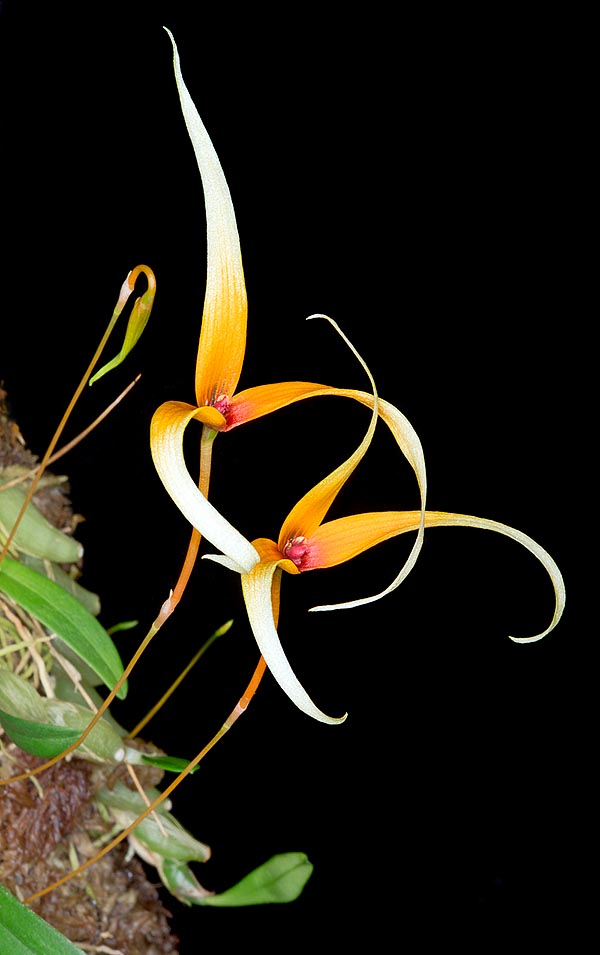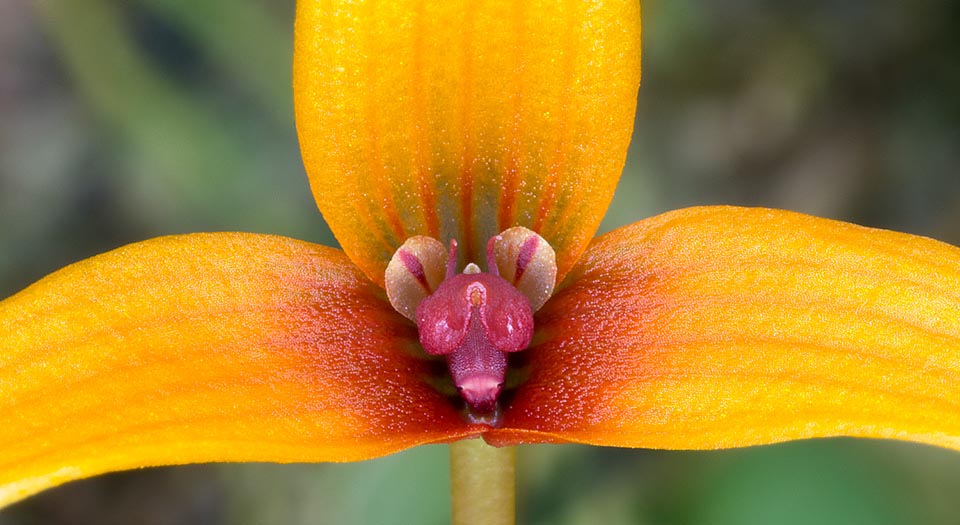Family : Orchidaceae

Text © Pietro Puccio

English translation by Mario Beltramini

Native to Bormeo, Peninsular Malaysia and Sumatra, the Bulbophyllum stormii is and epiphyte with creeping rhizome, at times ramified, with pseudobulbs arranged in continuous series © Giuseppe Mazza
The name of the genus is the combination of the Greek substantives “βολβός” (bolbos) = bulb and “φύλλον” (phyllon) = leaf, with reference to the leaves growing at the apex of the pseudobulbs; the species is honoured to the Dutch collector Storm van ‘s-Gravesande.
Common names: Storm’s bulbophyllum (Dutch).
The Bulbophyllum stormii J.J.Sm. (1907) is an epiphytic species with creeping rhizome, at times ramified, and pseudobulbs arranged in continuous series, oblong, slightly compressed laterally, 1-1,5 cm long and 0,5 cm broad, with at the apex a single lanceolate leaf with obtuse apex, 2,5-4 cm long and 0,6-0,8 cm broad, coriaceous.
Erect basal inflorescence, on a 1,5-4 cm long filiform peduncle, bearing one single flower with more or less intense orange sepals with reddish veins and shades more intense towards the base and purple labellum; 2-3 cm long ovary and pedicel. Almost equal sepals, lanceolate with long pointed apex, the dorsal erect, the lateral curved, 2,5-4 cm long and 0,4-0,5 cm broad, lanceolate petals with acute apex, 0,3-0,5 cm long and 0,1-0,2 cm broad, oblong mobile labellum, convex, 0,3-0,4 cm long, and about 2,5 mm long column.
It reproduces by seed, in vitro, and by division, with each section provided of at least 3-4 pseudobulbs.
Species with great flowers, compared to the minute dimensions of the plant, with warm and luminous colour, needs medium high summer temperatures, 22-32 °C, with high humidity, 70-80%, and frequent waterings, cooler temperatures in winter, 16-20 °C, and less frequent waterings, but without ever allowing the substratum to dry up completely, semi-shaded position and good ventilation.
For the waterings and nebulizations is to be used rain water, by reverse osmosis or demineralied; the fertilizations, duly distributed in way to avoid salts accumulation, are to be done preferably with hydrosoluble balanced products, with microelements, at 1/4 the dosage suggested on the package. It can be mounted on small trunks, pieces of bark or rafts with sphagnum at the base, or in pots of baskets with medium sliced bark, sphagnum and inerts for a best drainage. Like many Bulbophyllum is quite sensitive to the damage of the roots, therefore particular care is to be done in the repottings and in the displacements, that should be minimized.

Flowers with showy 2,5-4 cm orange sepals, 0,3-0,5 cm lanceolate petals and 0,3-0,4 cm oblong convex mobile labellum © Giuseppe Mazza
Synonyms: Bulbophyllum araniferum Ridl. (1914); Bulbophyllum longistelidium Ridl. (1924); Bulbophyllum tapirus J.J.Sm. (1928); Bulbophyllum tristriatum Carr (1930).
→ For general notions about ORCHIDACEAE please click here.
